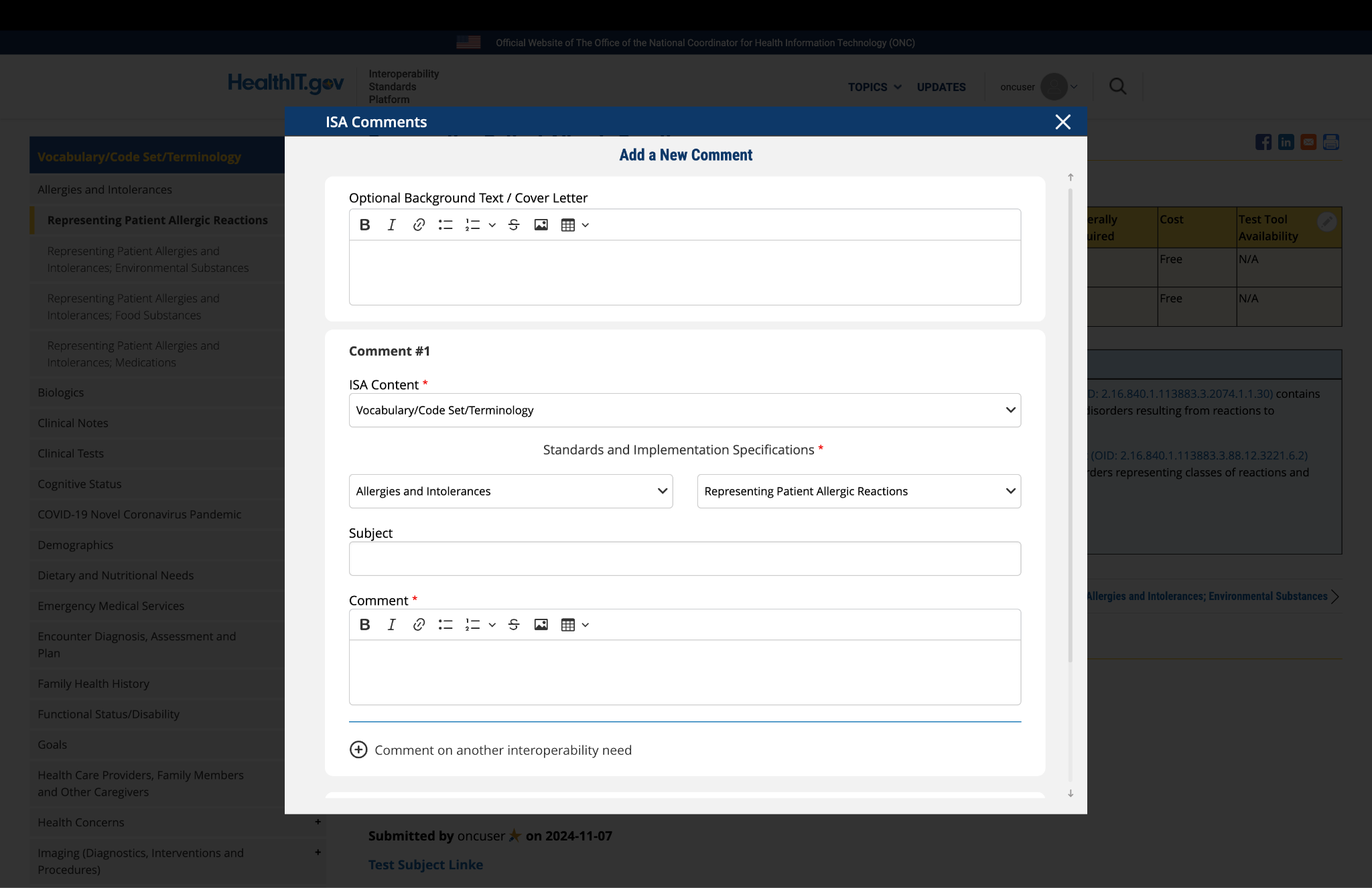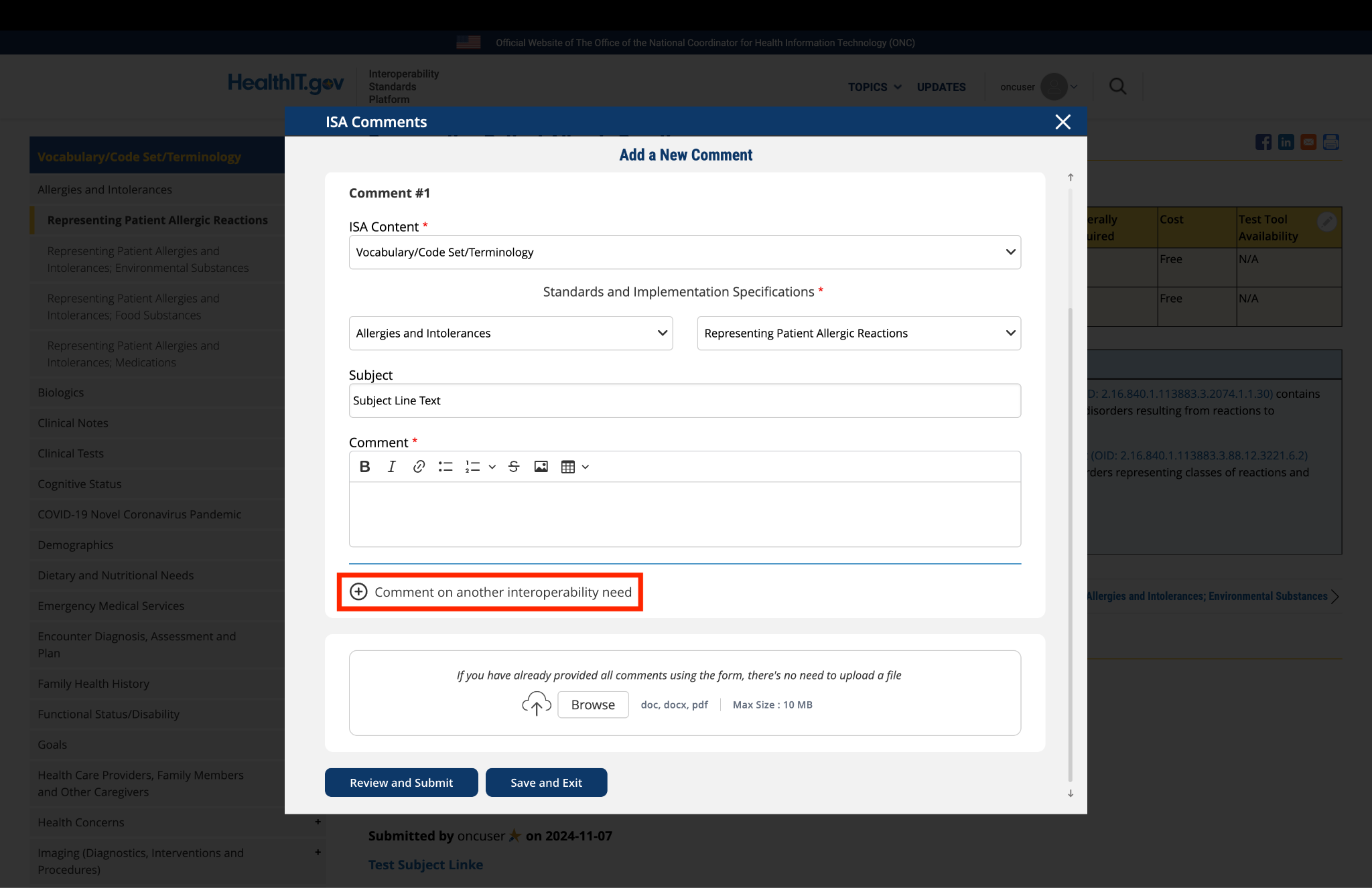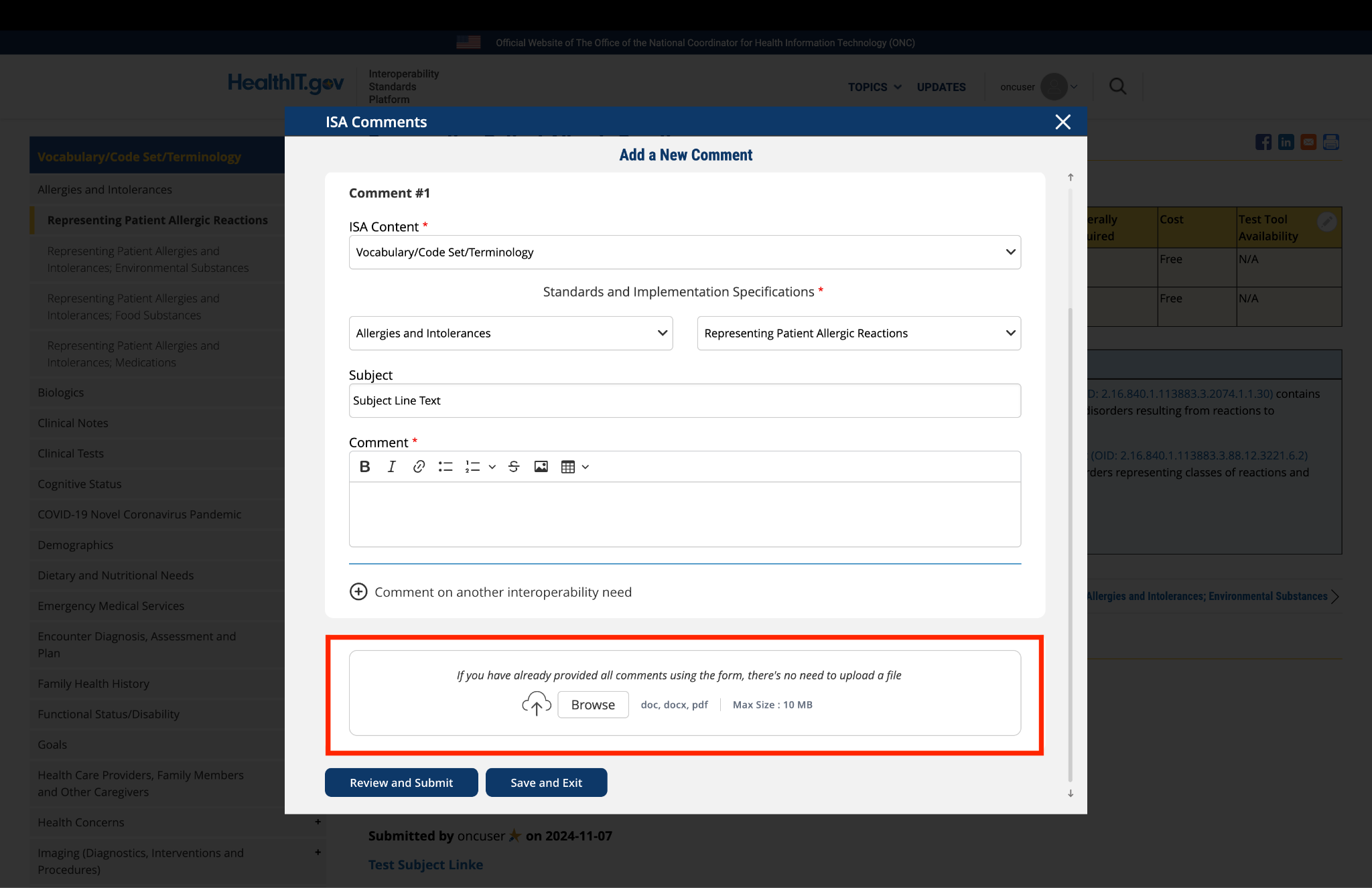| Type | Standard / Implementation Specification | Standards Process Maturity | Implementation Maturity | Adoption Level | Federally required | Cost | Test Tool Availability |
|---|---|---|---|---|---|---|---|
|
Standard for observation values
|
Final
|
Production
|
No
|
Free
|
N/A
|
||
|
Standard for observations
|
Final
|
Production
|
No
|
Free
|
N/A
|
||
|
Standard
|
Final
|
Production
|
Feedback Requested |
No
|
Free
|
No
|
| Limitations, Dependencies, and Preconditions for Consideration |
Applicable Value Set(s) and Starter Set(s)
|
|---|---|
|
|
Comment
Submitted by pwilson@ncpdp.org on
NCPDP Comments
Modify LOINC and SNOMED CT adoption levels to 1.
Submitted by gldickinson on
Preserving Clinical Context
General Comments:
USCDI specifies lots of clinical data classes and data elements
- Resolving to myriad de-coupled fragments
- With vanishingly little focus on:
- Clinical context and vital inter-relationships, e.g., between problems, diagnoses, complaints, symptoms, encounters, history and physical findings, allergies, medications, vaccinations, assessments, goals/objectives, clinical decisions, orders, results, diagnostic procedures, interventions, observations, treatments/therapies, referrals, consults, protocols, care plans and status...
- Elements and context + purpose of capture: e.g., blood pressure, its measurement (systolic, diastolic), its unit of measure (mm/Hg), its reason for capture, its context of capture (sampling site, sampling method, patient position, at rest/during/post exercise...
It is crucial to consider and determine/resolve how clinical content and context are bound together and preserved in USCDI. The ultimate end user (often a clinician) must be able to readily discern context and inter-relationships – otherwise USCDI places an undue (and often unresolvable) burden on this user. Only the source EHR/HIT system can structure clinical content and context properly. Once data is stuffed into the USCDI framework and related exchange artifact (e.g., FHIR resources) this opportunity is forever lost.
Submitted by mattreid on
The AMA requests that the…
The AMA requests that the Current Procedural Terminology (CPT) code set be added to the standards listed in Section I: Representing Patient Goals. CPT Category II codes for Health and Well-Being Coaching (0591T – 0593T) identify services for goal setting, education, and monitoring related to those goals.
CPT is a comprehensive and regularly curated uniform language that accurately describes medical, surgical, and diagnostic services and provides for reliable communication among users. It has an extremely robust and mature development process with open and transparent meetings and clinical input from national medical specialties and relevant stakeholders. It is the most widely adopted outpatient procedure code set. Use of the CPT code set is federally required under HIPAA.








Submitted by Mduchaj on
Functional goals for physical therapy
Why is writing goals based on the client’s priorities and in a consistent and easily understood format important? The answer is rooted in motor learning theory, reimbursement practices and health care policy. (Randall, McEwen, 2000) The goals communicate with your client, colleagues, referral source and other stakeholders about the intent and focus of the intervention.
Improved patient participation and setting expectations.
Current motor learning theory suggests that patient engagement in treatment is enhanced when personally meaningful goals are prioritized. Setting goals is collaborative. For clients with the ability to articulate goals, this process progresses smoothly. For other clients, determining realistic, achievable, yet challenging goals requires more negotiation. This presents the opportunity to set expectations for short and long term outcomes for patients with chronic problems. Regardless of the process, involvement of the client in goal setting has been demonstrated to improve participation and achievement. (Sugavanam, Et.al., 2013)
Medical necessity and reimbursement
Demonstrating achievement to all stakeholders necessitates clear parameters to determine if goals have been met or not met. Achievement of the client’s goals for the intervention is the primary criterion for discharge from rehabilitation services. (APTA Guide to Physical Therapist Practice 4.0) On a clinical level, quantification of current function and determination of change in that function to achieve the intended outcome is the basis. A client walking at 0.80 m/s will be unable to clear the crosswalk on a city street within the “pedestrian time” of traffic lights. Increasing velocity to 1.10 m/s will be a goal that is needed to achieve the outcome of safely walking to the market. (USDOT, 2023) Third party review for reimbursement also uses goals as an indication of individualization of the POC. (Snyder, 2009) Goals that are specific to the client’s self-identified needs coupled with an appropriate intervention avoid denial for medical necessity. Additionally, the ability to simply and specifically measure the progress toward, and achievement of the goals supports appropriate progression and discharge recommendations.
Health care policy
The CMS National Quality Strategy (2022) places the patient at the center of care. Embedding Quality and Increasing Alignment are 2 of the 8 goals for the plan. The use of patient centered functional goals and Patient Reported Outcomes measures are two of the many ways to participate with these important regulatory changes. Patient reported functional outcomes tools and performance-based tools can be included in goals as they indicate a change in function. The MCID of the tool, threshold scores for performance-based tests or prior level of function scores from the client history provide the benchmarks for writing goals.
Our Current State
Despite efforts to improve this portion of the Plan Of Care, challenges still exist. Many documented goals are not stated in terms that are measurable or functional. Performance of the home program is frequently cited as a goal when it is actually the treatment to achieve the goals. When the desired goal is for return to previous leisure or cardiovascular exercise, or prevention of regression through exercise prescription, the goal should be stated as such. A strategy for developing goals can be initiated based on the purpose of patient centered functional goals.
Plan for improving goal writing
Goals are the intended impact on functioning as a result of implementing the management plan to meet the unique needs of each client. Goals are measurable, functionally driven, and time limited. (APTA Guide to Physical Therapist Practice 4.0)
Goals can be found in the following domains: self-care, home management, work (play for a child), leisure activity and prevention. Documentation will be included in the “Subjective” or “Patient Goals” portion of the Evaluation. This is followed by a focused examination to identify and quantify contributing factors. In organizing the data derived from the examination, the ICF model is helpful to categorize affected body structures and functions. These initial measures are necessary to validate the need for a goal.
After deciding on the general outcomes, the goals that lead to those outcomes are identified. The recommended format includes: Who will do What, under what Conditions, how Well, Why by When?
Who is always the client. This also includes situations where physical assist or set up is needed. The goals focus on the client performing and activity and level of assist, not on the effort expended by the caregiver.
Will do what is an observable activity that has a beginning and an end. Walking, lifting, climbing are discreet examples of these. They may be components of the Outcome.
Under what conditions is the measurable portion of the goal and is unique to the client and may include distance or time. Achievement verses failure of a task can also be the implied measure, like standing from an 18” chair w/o UE support verses being unable to complete that activity under those conditions. Range of motion or strength measures are rarely appropriate as metrics to determine performance of an activity. The activity is the goal and the associated functional parameters.
How Well includes presence or absence of assistance needed, extended time, success rate or adapted techniques. Pain free or pain tolerated could also be indicated. Terms like “proper posture” would be more professionally described as “neutral spine positioning.”
Why returns to the intended outcome. This identifies the larger construct: Return to work or independent grocery shopping. Prevention of disease progression or mitigation of safety risk can also be addressed.
We also use the acronym SMART (Doran, 1981) to describe goal writing. This paradigm integrates with the same elements listed above:
Specific - What
Measurable - Conditions
Assignable - Who
Realistic – How well
Time-related – When
Regardless of the method used to format the information, the goals for the intervention should be stated in concise language that allows any stakeholder to clearly understand the intended direction and criteria for conclusion of the intervention.
Search | APTA Guide to Physical Therapist Practice
ICF Browser (who.int)
Writing patient-centered functional goals - PubMed (nih.gov)
The CMS National Quality Strategy: A Person-Centered Approach to Improving Quality | CMS
'Finding a balance' in involving patients in goal setting early after stroke: a physiotherapy perspective - PubMed (nih.gov)
The Relationship Between Client-Centered Goal-Setting and Treatment Outcomes | Perspectives on Neurophysiology and Neurogenic Speech and Language Disorders (asha.org)
Navigating patient-centered goal setting in inpatient stroke rehabilitation: how clinicians control the process to meet perceived professional responsibilities - PubMed (nih.gov)
Recognizing potential barriers to setting and achieving effective rehabilitation goals for patients with persistent pain: Physiotherapy Theory and Practice: Vol 32, No 5 (tandfonline.com)
Goal setting and strategies to enhance goal pursuit for adults with acquired disability participating in rehabilitation - Levack, WMM - 2015 | Cochrane Library
Full article: Goal-setting in physiotherapy: exploring a person-centered perspective (tandfonline.com)
Poster 96: Successful Medical Necessity Documentation Improvement Strategies - ClinicalKey (liblynxgateway.com)
(PDF) Analysis of Physical Therapy Goals in a School-based Setting: A Pilot Study (researchgate.net)
Traffic Signal Timing Manual: Chapter 5 - Office of Operations (dot.gov)